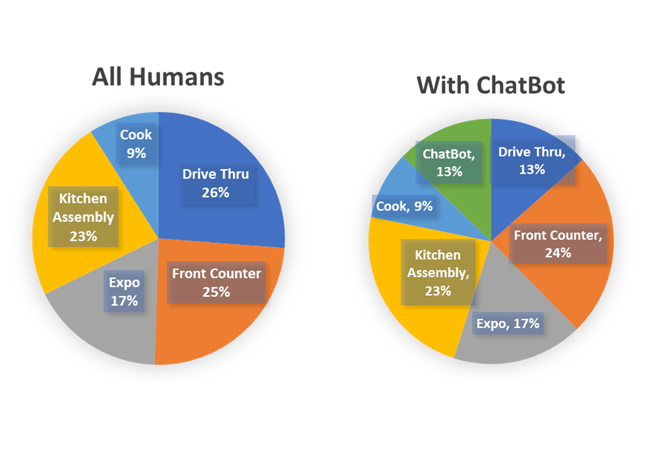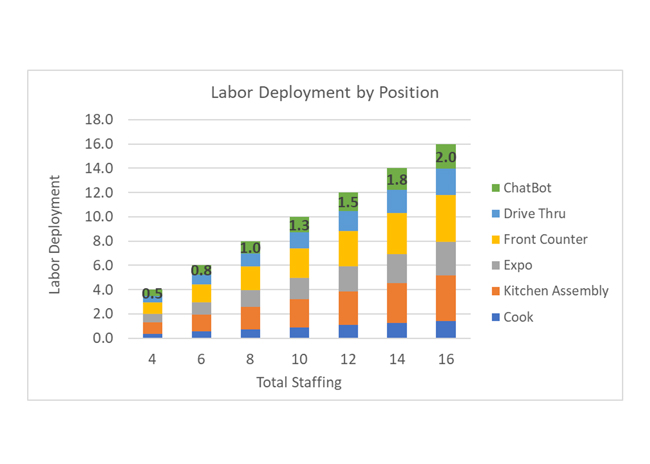If you attended any foodservice-related trade shows recently, I am sure you saw many robotic arms and machines being used in kitchen applications like frying chicken or making coffee.
While attractive and full of potential, it’s important to note these robots also require substantial investment and maintenance on a per-unit basis. For some concepts, the operator might need one robot per application, say one for the fryer and another for the coffee maker. In those instances, the amount of money spent on the physical robots, the software development and testing could add up rather quickly. That’s why so much of the robot use right now is concentrated at the chain level. These companies have the time and other necessary resources to make this happen. But that’s not to say automation is not making inroads in other parts of the restaurant industry.
In fact, other forms of automation, while not as sexy as robotic arms, continue to have an immediate impact on the foodservice industry. In my last blog, I wrote about artificial intelligence and how it can impact foodservice. The drive-thru, an integral part of modern fast-food culture, continues to experience a huge transformation fueled by cutting-edge technology. AI-powered chatbots are basically placed in traditional drive-thru squawk box and have the potential to rapidly reshape the drive-thru experience. Earlier this summer, White Castle made news when it announced plans to add AI to 100 drive-thru locations. Implementing such a system requires significant computing power and many hours of programming, but each restaurant does not need an individual robot for its implementation, so the rollout of AI technology is more scalable than robotics at the moment.
The article about White Castle implementing AI in the drive-thru says the system will take and process orders within 60 seconds, a time that while reasonable for today’s drive-thru standards is a bit slow. For example, it usually takes 40 to 50 seconds to receive and process a typical in-person drive-thru order during a lunch period. That would mean while the 60-second order-taking benchmark is comparable to current drive-thru standards, the bots are at least 20% slower than the average time it takes a person to perform the same task. If those 60 seconds relate to time at the menu board, including the time between one car finishing its order and the next car beginning theirs (which is typically 7 to 10 seconds), that would be closer to in-person order-taking throughput.
For a QSR where the drive-thru accounts for 55% to 60% of the location’s transactions, we could expect about 26% of the total labor to be dedicated to the drive-thru order processing, which includes order taking, payment and delivery to the customer. By completely replacing the order taker with a chatbot, that number would go down to about 13%, with the chatbot taking on the other 13% of the total workload.

So, what does this all mean for the amount of labor for a QSR using AI at the drive-thru? Well, a typical quick-service restaurant usually has 8 to 10 people working at one time. As the following chart notes, the chatbot or AI order taker could help reduce headcount by 1 to 1.3 people. You could see this kind of deployment in restaurants doing $1,000 to $1,300 per hour in revenue or 80 to 110 transactions per hour.

Also, many quick-serve restaurants operate at very low volumes for many hours of the day. During these low volume periods, using a bot might free up a crew member to perform other duties such as taking payment and delivering the order at the window, likely increasing throughput by potentially eliminating some operational bottlenecks.
It is also worth noting that as volume increases, single order points in a drive-thru create a bottleneck. For the restaurant to increase the volume it must do so by bringing orders in through a different channel or by adding additional order points. This often leads to adding multi-lane or multi-order points to a location. Even though this sounds complex when implementing AI ordering, the system might be better suited to handle this kind of operation. The same applies when using in-person ordering. A big challenge with multi-order point systems is the sequencing of orders so that when the car gets to the window or order fulfillment area, they are in the order the crew expects. AI could use car identifiers and license plate readers to re-order cars if necessary and match KDS data to drive-thru lane car stack data without operator intervention.
Looping back into the design aspect of the drive-thru environment, a traditional single order point could process 65 to 70 cars per hour. If the AI order system takes 60 seconds, we would expect a maximum throughput of 50 to 60 cars per hour. Doubling the order entry terminal should give us a capacity of about 130 cars per hour with traditional ordering and 100 cars per hour with AI Ordering.
The drive-thru experience is no longer confined to staffed order terminals. Thanks to artificial intelligence, it's becoming a reliable, personalized, and efficient interaction between customers and restaurants. As AI technology continues to advance, the drive-thru is set to further enhance the operation by predicting orders and suggesting menu items to customers, creating a win-win situation for both businesses and customers in the fast-food landscape of the future.




